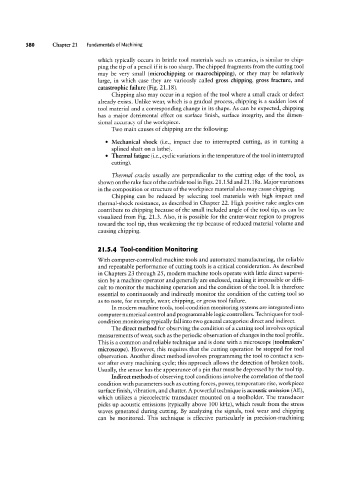Page 599 - 04. Subyek Engineering Materials - Manufacturing, Engineering and Technology SI 6th Edition - Serope Kalpakjian, Stephen Schmid (2009)
P. 599
80 Chapter 21 Fundamentals of Machining
which typically occurs in brittle tool materials such as ceramics, is similar to chip-
ping the tip of a pencil if it is too sharp. The chipped fragments from the cutting tool
may be very small (microchipping or macrochipping), or they may be relatively
large, in which case they are variously called gross chipping, gross fracture, and
catastrophic failure (Fig. 21.18).
Chipping also may occur in a region of the tool where a small crack or defect
already exists. Unlike wear, which is a gradual process, chipping is a sudden loss of
tool material and a corresponding change in its shape. As can be expected, chipping
has a major detrimental effect on surface finish, surface integrity, and the dimen-
sional accuracy of the workpiece.
Two main causes of chipping are the following:
° Mechanical shock (i.e., impact due to interrupted cutting, as in turning a
splined shaft on a lathe).
° Thermal fatigue (i.e., cyclic variations in the temperature of the tool in interrupted
cutting).
Thermal cracks usually are perpendicular to the cutting edge of the tool, as
shown on the rake face of the carbide tool in Figs. 21.15 d and 21.18a. Major variations
in the composition or structure of the workpiece material also may cause chipping.
Chipping can be reduced by selecting tool materials with high impact and
thermal-shock resistance, as described in Chapter 22. High positive rake angles can
contribute to chipping because of the small included angle of the tool tip, as can be
visualized from Fig. 21.3. Also, it is possible for the crater-wear region to progress
toward the tool tip, thus weakening the tip because of reduced material volume and
causing chipping.
2I.5.4 Tool-condition Monitoring
With computer-controlled machine tools and automated manufacturing, the reliable
and repeatable performance of cutting tools is a critical consideration. As described
in Chapters 23 through 25, modern machine tools operate with little direct supervi-
sion by a machine operator and generally are enclosed, making it impossible or diffi-
cult to monitor the machining operation and the condition of the tool. It is therefore
essential to continuously and indirectly monitor the condition of the cutting tool so
as to note, for example, wear, chipping, or gross tool failure.
In modern machine tools, tool-condition monitoring systems are integrated into
computer numerical control and programmable logic controllers. Techniques for tool-
condition monitoring typically fall into two general categories: direct and indirect.
The direct method for observing the condition of a cutting tool involves optical
measurements of wear, such as the periodic observation of changes in the tool profile.
This is a common and reliable technique and is done with a microscope (toolmakers’
microscope). However, this requires that the cutting operation be stopped for tool
observation. Another direct method involves programming the tool to contact a sen-
sor after every machining cycle; this approach allows the detection of broken tools.
Usually, the sensor has the appearance of a pin that must be depressed by the tool tip.
Indirect methods of observing tool conditions involve the correlation of the tool
condition with parameters such as cutting forces, power, temperature rise, workpiece
surface finish, vibration, and chatter. A powerful technique is acoustic emission (AE),
which utilizes a piezoelectric transducer mounted on a toolholder. The transducer
picks up acoustic emissions (typically above 100 kHz), which result from the stress
waves generated during cutting. By analyzing the signals, tool wear and chipping
can be monitored. This technique is effective particularly in precision-machining

